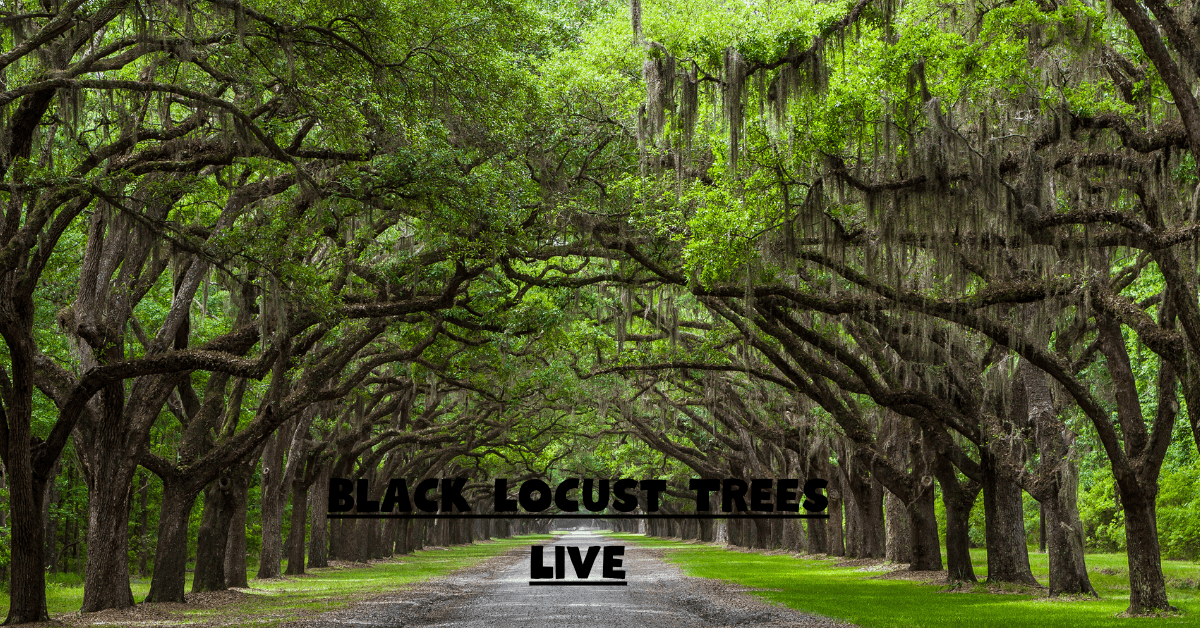Black Locust Trees Live: Dark beetle bushes (Robin pseudo acacia) are eminent for their quality, strength, and computer program. They are in North America and have watched their way into scenes worldwide. One common question among fans and tsarists is, “How long does dark grasshopper timber remain?” In this direct, we dive into the life expectancy of dark grasshopper timber, components impacting their strength, and care insights to ensure their wellness and energy.
How Long Do Dark Beetle Trees Live?
Black beetle trees have a life expectancy regularly extending from 70 to 100 years, in spite of the fact that super examples can live as much as 150 years or more underneath the best-of-the-line situation. Variables such as natural conditions, soil quality, bugs, ailments, and human interferences play significant parts in determining the durability of timber.
-
Dim insect trees, also known as coal black trees, have a place to sort Radioscopy. These trees are eminent for their thick, dim wood, which is exceedingly esteemed for its quality and magnificence. The life expectancy of dull, creepy-crawly trees can change depending on a few components, including species, natural conditions, and human impacts.
-
In general, dim insect trees are generally long-lived, with a few species able to survive for a few hundred years under great conditions. However, numerous components can influence their lifespan.
-
Environmental components such as climate, soil quality, and water accessibility significantly determine dim insect trees’ well-being and life span. In locales with cruel natural conditions or destitute soil quality, the life expectancy of these trees may be shorter compared to zones with more favourable conditions.
-
Additionally, dim insect trees confront different dangers from human activities, including deforestation, territory annihilation, and illicit logging. These activities can affect the life expectancy of dull, creepy crawly trees by decreasing their living space and exposing them to stressors such as bothers and diseases.
-
Conservation endeavours aimed at ensuring dim insect trees and their living spaces are essential for guaranteeing their long-term survival. By protecting these profitable trees and their biological systems, we can help maintain their populations and guarantee that future generations can benefit from their excellence and utility.
-
Overall, whereas dim insect trees have the potential to live for a long time, their life expectancy is affected by a complex interaction of components, including natural conditions and human activities. Securing these trees and their environments is vital for protecting their lifespan and guaranteeing their continued presence in the wild.
Factors Affecting the Life expectancy of Dark Beetle Trees
The life hope of dim insect trees, like any living life form, is impacted by a vast number of natural and outward variables. Here’s a point-by-point investigation of a few of these factors:
- Species Specifics: Dull creepy crawly trees, like any species, have inborn characteristics that impact their life expectancy. This incorporates hereditary characteristics acquired from their parent trees, which can influence their well-being to disorders and their capacity to withstand natural stresses. Diverse species of dim, creepy crawly trees may have changing life anticipation due to these hereditary factors.
- Environmental Conditions: Natural variables are critical in deciding the life anticipation of dull, creepy crawly trees. This incorporates viewpoints such as climate, soil quality, and water accessibility. Dull creepy crawly trees regularly flourish in particular natural conditions, and deviations from their perfect territory can influence their development and life span. For example, drawn-out dry spells or over-the-top precipitation can stretch the trees, making them more vulnerable to disorders and bothers and eventually shortening their lifespan.
- Disease and Bothers: Dull creepy crawly trees, like numerous other tree species, are defenceless to different illnesses and bother perversions. Pathogens such as microscopic organisms and infections can debilitate the trees’ resistant frameworks, driving them to decay and pass. Specifically, dull, creepy crawly trees may be helpless to perversions by creepy crawlies or borers, which can bore into the wood, disturbing the supplement stream and causing essential harm. Viable administration techniques, such as reasonable discovery and treatment of infections and bugs, can assist in dragging out dim insect trees’ life anticipation.
- Competition and Asset Accessibility: Competition for assets such as daylight, water, and supplements can affect the development and survival of dull crawly trees. In thickly forested zones, competition from neighbouring trees for assets may constrain the development potential of person trees, influencing their general well-being and life span. So also, soil quality and supplement accessibility can change over diverse areas, impacting the development rate and versatility of dim insect trees.
- Human Exercises: Human exercises such as deforestation, environment fracture, and contamination can negatively impact dull, creepy-crawly trees and their environments. Deforestation poses a noteworthy risk to the survival of dull, creepy crawly trees by lessening their territory and uncovering them to extra stresses such as soil disintegration and climate change. Contamination from mechanical exercises or rural runoff can corrupt soil and water quality, compromise the well-being of dull-crawly trees, and contribute to their decline.
- Climate Alter: Climate change is progressively perceived as a significant danger to the well-being and lifespan of trees worldwide. Rising temperatures, modified precipitation designs, and extraordinary climate occasions related to climate change can disturb biological systems’ fragile adjustsystems, influencing the development, propagation, and survival of dull, creepy crawly trees. For illustration, hotter temperatures may support the expansion of bugs and pathogens that target dim insect trees. In contrast, more frequent dry seasons can compound water push and debilitate the trees’ thickness.
Environmental Conditions
Black grasshopper bushes flourish in various climates, from sticky subtropical locales to calm zones. Be that as it may, they select total sun and well-tired soils. Unforgiving natural conditions, including dry season or over-the-top cold, can weigh the bushes, diminishing their lifespan.
Soil Quality
These trees are versatile to a gigantic assortment of soil sorts, incorporating clay, soil, and sandy soils, but they perform palatably in decently prolific, marginally acidic soils. Destitute soil first-rate, compaction, or waterlogging can limit their increment and abbreviate their lifespan.
Pests and Diseases
Black grasshopper timber is exceedingly confirmation against bothers and ailments. However, they can still drop sufferer to, beyond any doubt, bugs like beetle borers and afflictions like cankers and delicate gentle. Customary observing and fitting bug and illness control hones can help relieve these dangers and stretch the tree’s lifestyles.
Human Interventions
Human activities, such as imperfect pruning, soil compaction from creation, and pollution, can affect the wellness and sturdiness of dark beetle bushes. Cautious arrangement and support can constrain those negative impacts and advance tree durability.
Care Tips for Dark Beetle Trees

- Planting: Select a sunny region with nicely-drained soil for planting dark grasshopper bushes. Maintain a strategic distance from areas helpless to water logging or compacted soil.
- Watering: Give supplemental watering at a few points of dry term, unusually inside the to begin with few a long time after planting, to help set up durable root structures.
- Pruning: Prune dark grasshopper bushes frequently to kill futile, ailing, or harmed branches and advance wholesome development—Dodge intemperate pruning, which can push the tree.
- Fertilising: Apply adjusted manure in early spring to give critical vitamins for development and improvement.
- Mulching: Mulch around the tree’s base to keep dampness, alter soil temperature, and smother weeds. Utilise natural mulch like wood chips or bark.
- Pest and Illness Administration: Screen the tree as often as possible for signs of bugs and ailments and take appropriate action if identified. Consult an authorised arborvitae for effective control strategies.
FAQs About Black Locust Trees Live
Q. Are dark grasshopper trees speedy-growing?
Yes, dark grasshopper timber is perceived for its expedient boom charge, basically because of its early age. It can grow up to 2 feet or more prominent in keeping with the year beneath ideal conditions.
Q. Do dark beetle bushes have obtrusive roots?
While dark grasshopper bushes have impressive root structures, they are no longer considered obtrusive. However, caution should be exercised when planting them close to frameworks or underground utilities.
Q. Can dark beetle timber be utilised for construction?
Yes, dark grasshopper wood is massively prized for its sturdiness and resistance to decay, making it perfect for exterior development ventures, including decking, fencing, and fixtures.
Conclusion
In conclusion, dark grasshopper trees can remain for a few long time with the right care and upkeep. By skill, the variables affecting their life expectancy and implementing fitting care methods, property holders, landscapers, and tsarists can encounter the magnificence and endowments of those amazing bushes for eras. Whether planted for colour, breakdown control, or timber generation, dark grasshopper trees keep captivating and empowering with their flexibility and sturdiness.

